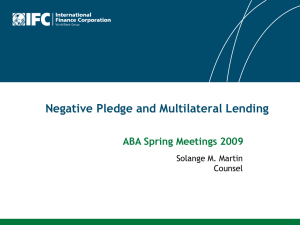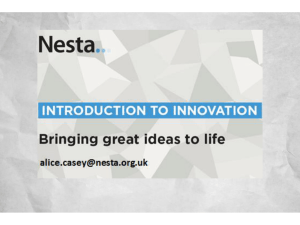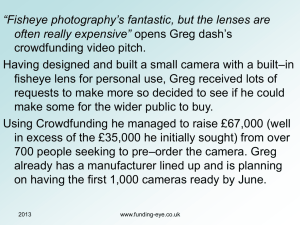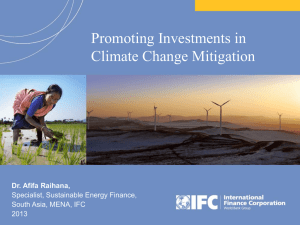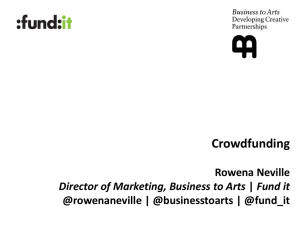Financial engineering, including investment approaches for
advertisement
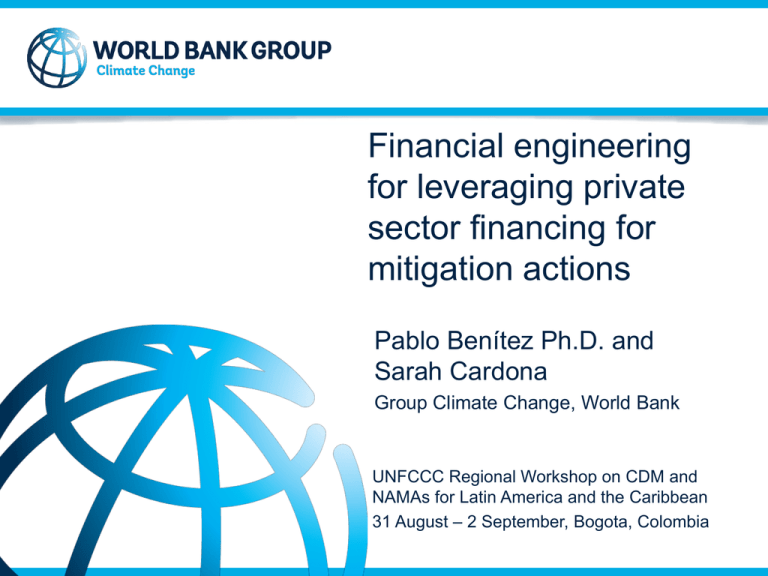
Financial engineering for leveraging private sector financing for mitigation actions Pablo Benítez Ph.D. and Sarah Cardona Group Climate Change, World Bank UNFCCC Regional Workshop on CDM and NAMAs for Latin America and the Caribbean 31 August – 2 September, Bogota, Colombia Strictly Confidential © 2013 Strictly Confidential © 2013 Overview In this presentation, you will learn about: • Innovative finance approaches for leveraging the private sector • Specific instruments, including risk mitigation instruments and those used by multilateral development banks • Concrete examples of innovative finance supporting climate action Screen # of ## Climate Change Key Obstacles to Climate Investment Insufficient access to financing Higher Upfront Costs Insufficient Returns Excessive risk Private Sector Participation Climate Finance Investment Screen # of ## Climate Change Financial Engineering: Innovative Finance Innovative Finance Generate additional funds • New funding sources • Solidarity taxes • Emerging donors • Institutional investors Enhance efficiency of flows • Reduce delivery time and costs • Frontloading of development aid • Index-based risk financing Link flows to results • Results-Based Financing • Advance Market Commitments Source: IF for Development Solutions Screen # of ## Climate Change Innovative Climate Finance Approaches Grants Mezz Concessional Debt Leverage Credit Enhancement Blending Combined Finance Revenue Enhancement Alternative source of financing for SMEs Equity Technology Transfer Technical Assistance Screen # of ## Climate Change Leverage • Leverage shows how much private money was mobilized on the back of a public dollar. • MDB experience: leverage factors in the range of 2 to 5 for non-concessional lending can be significantly higher where the public finance is concessional lending, grants or equity (8 to 10 or higher) • MDB flows and carbon offset flows could leverage around US$100-200 billion in 2020 in additional gross international climate-related private flows Screen # of ## Climate Change The Clean Technology Fund (CTF) Support to MENA Concentrated Solar Power Initiative OVERALL OBJECTIVE: Reduce the costs of Concentrated Solar Power (CSP) technology through economies of scale and learning effects from replication, enabling the Middle East and North Africa (MENA) region to contribute to global climate change mitigation. Financing: $750 million of highly concessional funding from the Clean Technology Fund (CTF) that acted as a catalyst to leverage public and private investments for CSP power plants and other related projects for over $4.85 billion in co-financing from private and public sources including: $1.3 billion from the private sector, $2 billion from the local government, and $1.5 billion from the African Development Bank and the World Bank. Screen # of ## Climate Change IFC’s Experience Understanding Leverage • There is great potential in leveraging private sector climate-related investment through multilateral development banks. • IFC’s experience has shows that 1 dollar of IFC climate-related investment brings in close to 3 additional dollars from other investors on average. • One dollar of IFC investment has itself been leveraged on the strength of IFC’s shareholder capital. • The private sector does not behave in a homogeneous fashion. There are variations depending on technology and market characteristics which determine the leveraging potential emerging from the private sector. Screen # of ## Climate Change Climate finance in practice can refer to different investment needs Blending • Funds invested at concessional, or below market, rates combined with an organization’s own funds. • Tailored to address the high cost of early market entrants • Typically provided to address issues of liquidity, tenor and cost of funds • Can be linked to achieving desired results through interest rate reductions, longer tenors, or with different rank and security packages • Range of products: risk sharing products, lower interest rates, longer tenors, subordinated rank in loans, or lower returns for equity investments. Screen # of ## Climate Change Clean Technology Fund support to Private Sector La Ventosa Wind in Mexico OVERALL OBJECTIVE: Finance wind power technology through concessional debt to accelerate technology roll out, enabling Mexico to significantly reduce its CO2 emissions annually. Financing: $15 million in CTF funds through the IFC (private sector arm), IFC provided $24 million commercial financing from its own account, and blended finance from the IDB and US Export-Import Bank, contributing to project costs of $195 million. Screen # of ## Climate Change Stimulating Private Sector Participation in EE and Small-Scale RE in Turkey OVERALL OBJECTIVE: TURSEFF, the Turkish Sustainable Energy Finance Facility, provides a combination of commercial-priced finance with concessional co-finance and substantial TA support to commercial banks in Turkey for on-lending to EE and small-scale RE. Financing: TURSEFF loan package consists of: • EBRD loans, complemented by concessional financing • TA grant from the Clean Technology Fund • TA from the EU to support project implementation Screen # of ## Climate Change Blended Finance Unit (BFU) at IFC Quick Facts • Since 2006, 39 investment transactions have been committed using blended finance deploying concessional resources managed by IFC and including an IFC investment alongside. • 15 of these transactions have used guarantee instruments, 23 have used debt products, 1 project has used equity • A majority of the projects are investments made through Financial institutions • The leverage ratio for blended finance transactions through financial institutions is quite high: on average one dollar of concessional finance leveraged more than 13.8 dollars of investment on the ground, including 9 dollars of IFC investment, that would not have taken place without such risk mitigation support. • These projects often involve an emerging area (venture capital or early stage funding of cleantech) or activities that have not yet entered the mainstream FI environment. Leverage ratios for these projects, at an average of 19.4 for total project cost and 3.5 for IFC funds to donor funds, hide significant variation between technologies. Screen # of ## Climate Change Combined Finance • Bundling different types of finance within a single project/program to make otherwise unattractive low-carbon projects attractive Leverage Blending • resources can be combined through a national financial mechanism, such as a national development bank or a trust fund, where resources are allocated together side by side. Combined Finance Alternative source of financing for SMEs Screen # of ## Climate Change Combined Finance Mechanism: National Climate Fund (NCF) Example: The China CDM Fund (CCDMF) • National fund that offers grants and loans • Supports China’s National Climate Change Program • Grants funded by revenues from CDM projects Fast Facts: • More than USD 81 million in grants committed to support over 200 projects • Direct reduction of over 7 million tonnes of CO2 equivalent through funding enterprises, mobilizing market capital and achieving verified emission reduction effects • Government representatives from Brazil, Vietnam, and Cambodia have already visited CCDMF to learn more about this type of climate financing Screen # of ## Climate Change Alternative Sources of Financing for SMEs Microfinance for energy Leverage Blending Combined Finance Alternative source of financing for SMEs Property Assessed Clean Energy (PACE) Pay-As-You-Save Publicly-traded investment funds Crowdfunding for energy Screen # of ## Climate Change Crowdfunding Models Donation-based crowdfunding: funders donate without expecting monetary compensation, average funding sought (US$) < $10,000, e.g.: http://Kickstarter.com Reward-based crowdfunding: funders receive a token gift of appreciation or prepurchase of a service or product, average funding sought (US$) < $10,000, e.g.: https://www.indiegogo.com/ Lending-based crowdfunding: Funders receive a debt instrument that pays a fixed rate of interest and returns principal on a specified schedule, average funding sought (US$) < $50,000, e.g. http://www.rangde.org Equity-based crowdfunding: Funders receive equity instruments or profit sharing arrangements, average funding sought (US$) < $250,000, e.g. http://crowdfunder.com Screen # of ## Climate Change Reward-based Crowdfunding for energy independent school in Kaštel Lukšić, Croatia OBJECTIVE: Create one of the first energy independent schools in the world Financing solutions: 1. Source: School’s own budget+ contribution from the local community+ UNDP SEED funding+ crowdfunding+ co-financing from the Fund for Environmental Protection and Energy Efficiency; 2. Leverage finance through crowdfunding: Within two month, the project raised $10,001 from 189 funders which enables the school to take up actions planed for step one (small-scale). Crowdfunding was combined with local funding raising events at this stage; 3. Crowdfunding embedded co-financing model to scale-up climate actions: Crowdfunding has helped to identify, communicate with and receive funding from targeted investors and potential stakeholders. After the best model is tested, with co-financing from institutional investors such as Fund for Environmental Protection and Energy Efficiency, the solution can be scaled up in other countries. Screen # of ## Climate Change Moving forward: approaches differ by sector Screen # of ## Source: IFC, 2010 Climate Change Summary: Innovative Climate Finance Approaches Grants Mezz Concessional Debt Leverage Equity Credit Enhancement Technology Transfer Revenue Enhancement Technical Assistance Blending Combined Finance Alternative source of financing for SMEs Screen # of ## Climate Change References and Resources Visit these links for more information: • IFC – Mobilizing Public and Private Funds for Inclusive Green Growth Investment in Developing Countries • IFC website – Blended Concessional Finance • IFC – Climate Finance: Engaging the Private Sector (Shilpa Patel, WRI) • Beyond the Sum of Its Parts – Blending Financial Instruments (2010) • CIF website • Blending Climate Finance through National Climate Funds • Crowdfunding's Potential for the Developing World • Catalizando el financiamiento para enfrentar el cambio climático • Innovative Climate Finance workshop by IDB • UNEP Innovative climate finance • infoDev’s report on crowdfunding • WRI’s Moving the Fulcrum: a primer on public climate financing instruments used to leverage private capital • The landscape of Climate Finance • Crowdfunding for Climate Change • Innovative Finance for Development Solutions Screen # of ## Climate Change Thank you Pablo Benítez, Ph.D. pbenitez@worldbank.org Senior Economist, Climate Change T: +1 202 4730736 1818 H Street NW, Washington, DC 20433 USA Strictly Confidential © 2013


